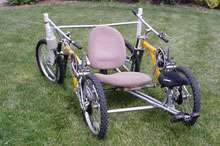No products in the cart.
Wheelchair Engineer

A Master of Do-It-Together Technology
By Paula M. Larson
We met in the desert. I was working in “Accessibility Camp” at the Burning Man Festival in Nevada, where our goal was to help folks with mobility issues get around the dusty desert setting more easily.
One day I noticed these handcycles, which are just what they sound like—cycles you power by cranking pedals with your arms instead of your legs—made from old bikes and wood. I was told the cycles were donated to the camp by a guy from Idaho named Randy. Having mobility issues myself, I was curious about the man who created these rugged contraptions and wanted to learn more about how (and why) he made them.
When I met longtime Meridian resident Randy Geile, I was surprised to see that he didn’t have mobility issues. Many people I know who pursue assistive technologies outside of academic settings have some physical issue themselves, or are close to someone who does. But not this mechanical engineer who has donated his time and energy to helping others since his retirement. That’s the second thing that struck me about Randy: his drive to help people, and to share his mechanical know-how to make it easier for mobility-challenged folks to get around. “It’s better to DIT than to DIY” is his philosophy, and “Do It Together” perfectly captures Randy’s outlook on his work.
In the desert, he was generous. Soon after we met, he gave me a “buddy bar” he built, with which a person riding a bicycle could push my wheelchair through the desert. I mentioned a man who who was having a difficult time getting around in the dust with his wheelchair, and the next day Randy gave the man a “third wheel” device he had made back home in Idaho, which made it easier for him to propel his wheelchair. I was intrigued by what had brought this physically mobile guy to the Nevada desert to help mobility-challenged people from across the country to get around.
He told me that after he retired, he was looking for a way to contribute to his community and stay busy. Little did he know that a chance encounter would eventually lead to a volunteer “career” helping people with all sorts of assistive technology needs.
“What got me into it was that I went to a volunteer fair and I ran into the Idaho Assistive Technology Project (IATP),” he said. ”For some reason, I just kind of connected with them and thought, ‘Well, you know, I’ll volunteer with these guys.’”
This content is available for purchase. Please select from available options.
Purchase Only
Purchase Only

